
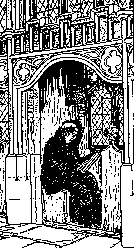
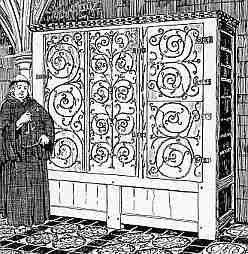
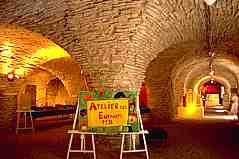
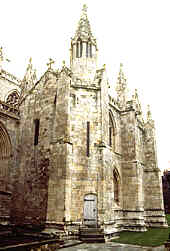
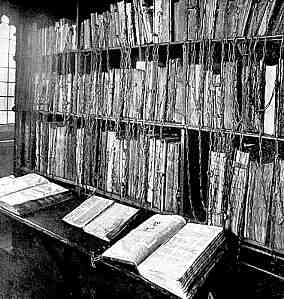
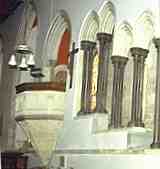
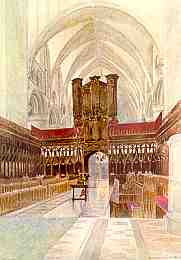
If you are looking at this page without frames, there is more information about medieval writing to be found by going to the home page (framed) or the site map (no frames).
| The Material Culture of Literacy (3) | |||||
| In the monasteries, reading and study were an important part of the work dedicated to God. | |||||
 |
These carrels in the cloister of Gloucester cathedral are supposedly where the monks studied, and presumably wrote, in the later middle ages. Without furnishings they seem very bare and pokey, and I would assume they must have been extended with wooden screens. Despite the windows in each booth, they must have been rather dark and confined. | ||||
| Study carrels in the cloister of Gloucester Cathedral. | |||||
 |
The sketch reconstruction shows a monk poked into one of these, without any extensions and with the only furniture being a simple bench and book rest, carved with the sort of bench end ornament which was found in the choir of the church. That sort of arrangement would hardly leave room for writing without banging your elbow, so I assume they are being regarded as reading carrels. What with the wind whistling around the cloister, life was not meant to be easy for a Benedictine monk. Did they store books in here for study, or did they have to get them out every time from the communal library? Whichever way it was done, then clearly they weren't all chained down. | ||||
| Up to around the 13th or 14th centuries, monasteries may not have had special rooms set aside for the library or scriptorium. Books were kept in cupboards, and loaned out for private study and contemplation. |
 |
||||
| The aumbry or cupboard represents a 13th century example surviving at St Werburgh's Abbey, Chester. The chubby monk with his keys comes from children's books of Robin Hood. | |||||
| Later, the library and scriptorium became part of the architecture of monasteries and major secular cathedrals or collegiate churches. | |||||
 |
 |
||||
| Above, the interior of former scriptorium of the Benedictine Abbey at Dijon, France, now part of a museum. At right, the scriptorium at Selby Abbey, Yorkshire was added to the church building, above the sacristy. | |||||
| Neither of these examples would seem to provide an environment exactly flooded with light, and one wonder exactly where they did their actual reading and writing. The cloisters at Dijon might have been quite pleasant, but those at Selby would have been very cold and damp. | |||||
 |
Surviving library catalogues indicate that books were sorted, classified and stored in particular shelves or cupboards within the library building. In some cases, books were actually chained to their shelves. This may have been to stop pilfering of these valuable commodities, or it may have had some sort of symbolic function. I prefer the latter explanation - a visual message that these books are in a communal space for the use of the community. | ||||
| The famous chained library of Hereford Cathedral. | |||||
 |
The monasteries also had their aural culture of the written word. Idle chatter was not permitted at meals, and the refectories were equipped with a pulpit from which one of the monks conducted readings during meals for the spiritual benefit of the other brethren. | ||||
| Wall pulpit in the former refectory of Beaulieu Abbey in Hampshire, now serving as the parish church. | |||||
 |
|||||
| The recitation of the divine office was a more elaborate and extended procedure in the monasteries than it was in secular churches. This reverence for the Holy Word affected the architecture and furnishings of the great monastic churches, which were built with large choirs and elaborate wooden choir stalls. The design was essentially similar, no matter what kind of church they were in, but the scale of these hidden sanctums was greater in the monasteries. Acres of elaborate figural carving covered the wooden choir stalls. | |||||
| The choir of Gloucester cathedral. In the medieval era this was not a cathedral, but a major Benedictine abbey. | |||||
|
|
|||||
|
|
|||||
|
If you are looking at this page without frames, there is more information about medieval writing to be found by going to the home page (framed) or the site map (no frames). |
|||||